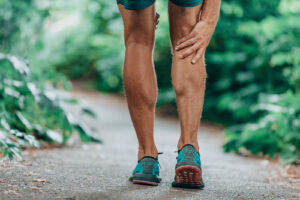
Love running, but don’t love the calf pain that comes with it? Pain in your calves has to be one of the most common complaints among people who run. But, it is also one of the most misunderstood problems, as well as one of the most annoying. So, want to get to the bottom of why this happens? What’s causing your calf pain? Is it something to be worried about? When should you be concerned, and what should you do? Let’s take a look at this:
Is it your shoes?
Most people examine their shoes when they experience post-running pain, so it’s not surprising that your footwear is your first suspect. However, trends in running shoes and across footwear are constantly changing. Right now, “minimalist” shoes are all the rage. Trainers like these are designed to reduce the likelihood of injury by making you run as naturally as possible, almost barefoot, while providing a barrier against your feet and the pavement or trail.
Have you heard of the heel-to-toe drop? As the name suggests, the heel-to-toe drop measures how much higher your heel is compared to your toes. Typical running shoes will have a drop of 12 degrees. However, other shoes drop 8, 6, 4, or even 0 degrees.
Though flatter shoes can help you run more efficiently, they also force you to run on your toes. This, in turn, increases the weight you distribute through your calf muscles. So, it’s not surprising that wearing new, flatter shoes all the time can cause your calves to work too hard.
If you think this is your problem, try breaking in your flat shoes by wearing them to walk most of the day and only doing shorter runs for the first while. You can also help out your calves in the meantime by strengthening them.
Is it a muscle tear?
People generally think it’s easy to spot a torn muscle. After all, you can typically expect sudden sharp pain or a pulling sensation, accompanied by dramatic swelling or bruising. But did you know that some muscle tears are a lot more subtle than this?
Your soleus muscle is the muscle that makes up the lower two-thirds of your calf. If you tear it, your soleus will just feel very stiff. If you keep using your soleus muscle, this stiffness will only increase until the pain forces you to stop running.
If you think you’ve torn your soleus muscle, the only thing to do is to rest until it heals. You can also try some strengthening exercises. Swap running for cycling or swimming, and consider visiting a physio.
Could it be a training error?
Have you made any drastic changes to your training routine recently? Unfortunately, some training routine changes lead to a considerable increase in the load on your calf muscles. As we touched upon, this can lead to calf muscle tightening or pain.
One training change that causes calf pain is hilly runs – running uphill forces you to run on your toes more, increasing your calf muscle load. Another is speed work. Changing your running style to run more on your mid-foot or forefoot too quickly can cause similar problems.
If you have recently changed your training routine that has led to your calf pain, “relative rest” may help. This is where you don’t completely halt your training but rest the body part that needs rest. Again, this could mean swimming, cycling, or shorter runs. Or introduce changes gradually.
Could your back be tight?
Have you ever heard of “increased neural tension”? It sounds serious, but neural tension simply refers to tightened muscles preventing your nerve sheaths from sliding as they need to. This tension in your nerve sheaths leads to discomfort lower down in your limbs.
The most common cause of neural tension is the piriformis muscle. Located in your buttocks, it’s common for the sciatic nerve – under the piriformis – to get squashed if this muscle gets too tight. Due to sitting for hours at office jobs, tight buttocks can cause a tight back, leading to calf pain. Tightness in your back can then be exacerbated by the wear and tear that comes with high-impact activity.
Thankfully, tightness in your back can easily be alleviated and prevented by regularly implementing a flexibility programme and stretching. Just be careful not to stretch your hamstrings too much while your calves are still tight.
Have you upset a nerve?
This one’s more serious. If you notice any tingling, sharp pains, numbness, or pain at night or calf pain, you’ve likely injured a nerve in your back. If this is the case, you probably won’t have back pain. This is because the sensation in your leg is too strong, thus blocking pain signals from your back. However, later on, as your calf pain starts to wane, you may notice more pain in your back. If this happens, you should get in touch with a physiotherapist.
Could it be shin splints?
Have you ever heard of medial tibial stress syndrome? More commonly known as shin splints, this condition often just feels like tight or stiff calves at first. However, you may also experience localised discomfort along the inside of your shin bone, specifically where the muscle attaches to your bone.
To begin with, you would only feel pain in your shins when exercising. As the condition worsens, however, you may also notice pain when merely walking or resting.
If you don’t seek treatment for this condition, it can quickly become a stress fracture. Neglecting this condition can also mean that it takes several months to resolve, which can really set your fitness regime asunder. So, consulting a physiotherapist is paramount if you experience pain along your shin bone. Book now at MGS Physiotherapy.
CALL NOW TO BOOK YOUR APPOINTMENT
